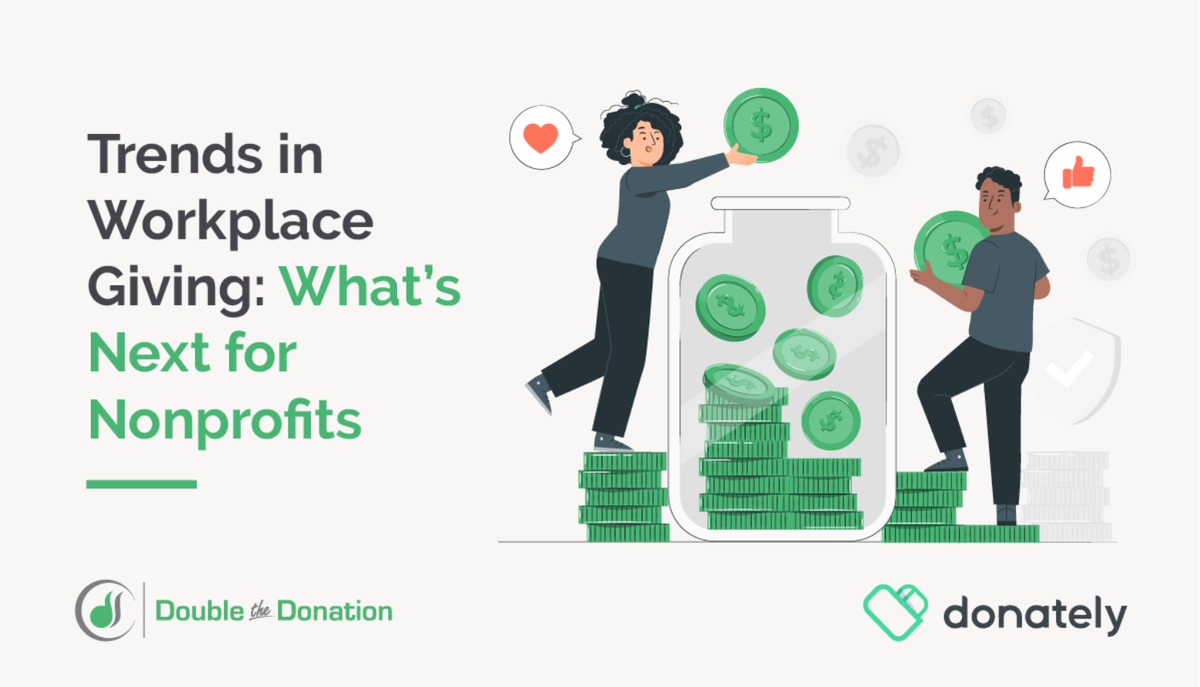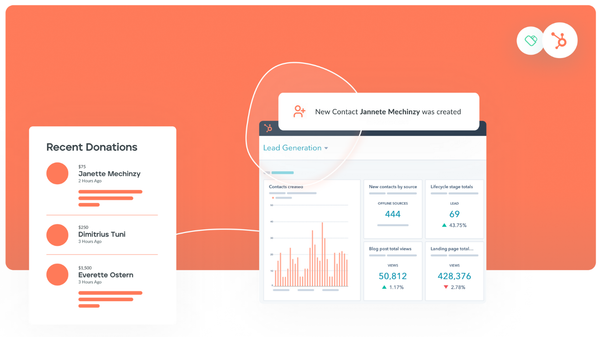Trends in Workplace Giving: What’s Next for Nonprofits?
Curious about the future of workplace giving? Dive into the latest trends with this handy guide from our friends at Double the Donation. From matching gifts to volunteerism and more, this article covers everything you need to know to keep your organization at the forefront of philanthropy.

Companies play a critical role in nonprofit fundraising, and their impact continues to grow as corporate social responsibility expands as a key business practice. When a company incentivizes its employee base to partake in its philanthropic efforts directly, that’s known as workplace giving.
Understanding the ever-evolving workplace giving landscape can empower your organization to make the most of the opportunity. In this guide, we’ll overview key trends we’re seeing—and expect to see—in the coming months and years. These include:
- New and extended matching gift programs
- Increased employee participation
- Streamlined digital engagement process
- Expansion of corporate volunteer incentives
- Custom workplace giving partnerships
- Year-round corporate philanthropy initiatives
Workplace giving has become a cornerstone strategy for nonprofit funding and engagement strategies—driving corporate and individual relations alike. As companies’ and donors’ involvement shifts to adapt to new technology, developing stakeholder expectations, innovative practices, and more, understanding how to best position the opportunities to your supporter base is a must.
Read on to get familiar with what’s currently happening—and what’s coming next!
New and extended matching gift programs
Tons of companies already partake in philanthropy by matching their employees’ donations to nonprofit causes. According to Double the Donation, this includes more than 24,000 companies employing nearly 27 million individuals. And more employers across businesses of all shapes, sizes, and sectors are rolling out new programs every day!
Not to mention, there’s a growing trend toward “unrestricted” matching programs (i.e., companies matching donations to any organization). Meanwhile, “restricted” ones (e.g., companies exclusively matching gifts made to higher education) are becoming increasingly rare. That means your organization can expect a greater likelihood of qualifying for the programs. Plus, many companies are raising their annual employee match limits, increasing their matching gift ratios, and more as a way of giving back to new heights.
Increased employee participation
Increased employee participation in workplace giving programs is another key trend benefiting nonprofits. As companies enhance their corporate social responsibility (CSR) efforts, they actively encourage employees to participate in philanthropy. As a result, organizations can access a larger, more engaged donor base with which to engage.With higher participation rates, organizations can receive a steady and predictable flow of donations, enhancing financial stability. Increased employee participation not only boosts immediate funding but also fosters long-term relationships with donors who may continue to support the nonprofit in various ways.
Streamlined digital engagement process
Most workplace giving programs involve a two-step process. For example, an individual would donate to your organization and request a matching gift from their employer. The latter step is one that’s being redesigned to offer a streamlined, frictionless experience for donors looking to get involved. And one of the best improvements to the process has been the development of matching gift auto-submission. That means employees from qualifying companies have the ability to bypass their standard submission form and auto-submit their gift with a single click.
Remember: when it’s easier for a company’s employees to support your cause by giving and securing corporate funds on your behalf, they’re more likely to do so. You just need to be sure you’re equipping your team with best-in-breed tools!
Expansion of corporate volunteer incentives
Financial gifts aren’t the only type of support being offered through corporate philanthropy initiatives, either. In fact, corporate-sponsored volunteerism (including programs like volunteer grants or volunteer time off) is on the rise.
More and more, companies are offering paid time out of the work day for employees to partake in volunteer activities, matching the value of volunteer hours via generous grants for nonprofit causes, and organizing team-wide volunteer events. For nonprofits, this trend translates into a more robust, increasingly dedicated volunteer force—ultimately reducing staffing costs and enhancing service delivery, too!
Custom workplace giving partnerships
Most companies’ workplace giving programs are open to a wide range of organizations their employees support. However, a growing trend in the industry is the introduction of “custom” or one-off partnerships between a company and a single nonprofit it chooses to support. This may mean matching gifts to a specific organization or offering paid time off to participate in group volunteer events for a chosen cause.Becoming familiar with this type of mutually beneficial partnership can empower your team to pitch tailored programs effectively and make the most of the unique opportunity before you. The result will be more sustainable funding streams and even open doors to new collaborative efforts.
Year-round corporate philanthropy initiatives
Some companies host limited-time employee giving campaigns as a way to rally staff support. This might include a holiday or year-end fundraiser or summer giving campaign. However, a growing number of companies are restructuring their philanthropy from time-bound initiatives to year-round programming.For nonprofits, this generally means more—and more consistent—corporate support and engagement opportunities. Unlike seasonal or one-off giving campaigns, year-round initiatives ensure a steady flow of resources and sustained engagement from companies and their employees. To make the most of the available support, you’ll want to establish comprehensive engagement plans that keep corporate partners and their employees actively involved throughout the year.
As the landscape of workplace giving continues to evolve around us, it’s essential that nonprofits like yours stay attuned to the shifting patterns. After all, understanding these trends allows you to supercharge your efforts and engage corporate partners and donors as effectively as possible.
By powering your team with the right technology to uncover opportunities in your donor base, personalizing your engagement efforts, and implementing a data-driven strategy, your team can position itself for success in the future of workplace giving. And the future starts now!





